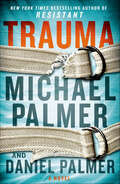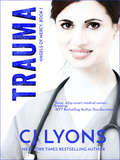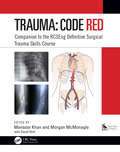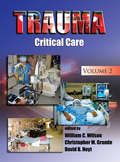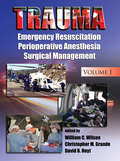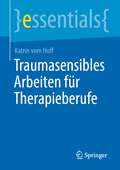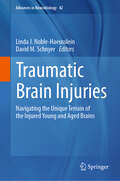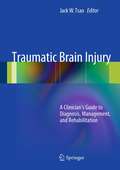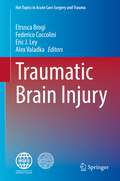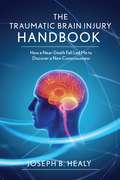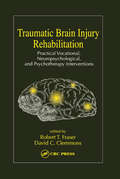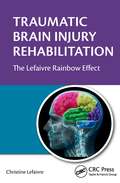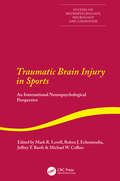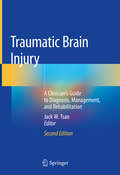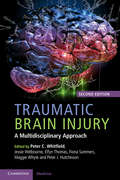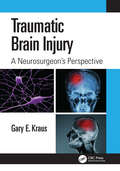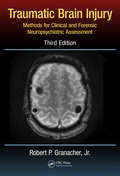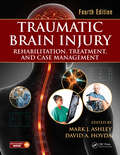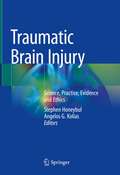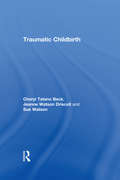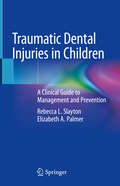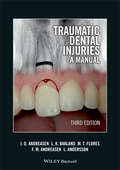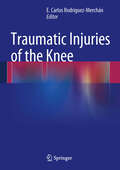- Table View
- List View
Trauma: A Novel
by Michael Palmer Daniel PalmerA disgraced surgeon gets caught in a puzzling conspiracy in this thriller by the New York Times–bestselling author and his acclaimed suspense novelist son.“Start reading and you won’t stop. A chilling medical thriller.” —Tess GerritsenDr. Carrie Bryant is a much-admired neurosurgical resident at an esteemed Boston hospital. When the relentless pace of her residency leads to a life-shattering error, Carrie loses her confidence—and decides to quit her residency and move back home. Her new life’s purpose: To help her combat-vet brother, Adam, recover from a crippling case of post-traumatic stress disorder.The experimental program at the VA Medical Center promises the possibility of curing the ravages of PTSD forever. It seems like Adam’s best option, but Carrie has her doubts when one of her patients goes missing . . . and then another. Carrie joins local investigative reporter David Hoffman in the hunt for answers. The hospital, however, is determined to keep its secrets at all costs. As Carrie and David descend into a labyrinth of murder and corruption, the price Carrie could pay for asking the wrong questions is her own life . . .“A unique novel that shows the strength of both authors’ work.” —Mystery Scene
Trauma: Angels Of Mercy Book 3 (Angels of Mercy Medical Suspense #3)
by CJ LyonsThird in the series that features “tense, whip-smart medical scenes . . . a gripping view of doctors at work” from the New York Times-bestselling author (Tess Gerritsen).Keeping secrets can be murder . . . Angels of Mercy ER charge nurse Nora Halloran has been living with a painful secret for three long years. But when a coworker is brutally assaulted and killed, she knows she can no longer remain silent.Determined to unmask the murderer, Nora teams up with her friends— Lydia, an ER attending with a secret of her own; Gina, the once-cocky resident now struggling to strike a balance between her family and her job; and Amanda, a med student caught between her career and her conscience. As the victim count grows, Nora must face her deepest fears and reveal all her secrets to save the man she loves in order to stop a monster . . . before he returns to silence her forever.(Previously published as Urgent Care)Praise for the Angels of Mercy series“A powerful and dramatic look into the frenzied world of emergency medicine . . . Lyons’ characters are dynamic and genuine.” —Suspense Magazine “A cast of four strong women . . . Un-put-downable pacing with interwoven plot lines. Dr. Lyons writes like a movie filmed without any cuts . . . Pick this book up if: you loved the TV show ER.” —ScienceThrillers.com“Lyons delivers a breathtakingly fast-paced medical thriller.” —Publishers Weekly
Trauma: Companion to the RCSEng Definitive Surgical Trauma Skills Course
by Mansoor Khan, Morgan McMonagle and David M. NottThe Royal College of Surgeons’ of England two-day “definitive surgical trauma skills course” is run by the authors. The course began in 1997 but a new syllabus has recently been put in place.The focus is on thoracic ,abdominal and vascular injuries, caused by both penetrating trauma, such as a knife, and ballistic trauma caused by guns.This Manual accompanies the course and it's aim is to “demystify the body” and show how to control massive blood loss. Interventions, whether they be military or civilian, are descrbed in full, and techniques derived from the battlefield and world-wide hotspots in trauma —are exemplified within this book.
Trauma: Critical Care
by Vladimir I. BakhmutovCompiled by internationally recognized experts in trauma critical care,this sourcediscusses the entire gamut of critical care management of the trauma patient and covers several common complications and conditions treated in surgical intensive care units that are not specifically related to trauma. Utilizing evidence-based guidelines where they ex
Trauma: Emergency Resuscitation, Perioperative Anesthesia, Surgical Management, Volume I
by Martin GardnerProduced by a world-renowned team of trauma specialists, this source reviews initial management considerations beginning in the pre-hospital phase, continues through the primary and secondary surveys of the hospital-based evaluation process, and proceeds to the perioperative management of trauma, burns, and associated conditions. This reference pro
Traumasensibles Arbeiten für Therapieberufe (essentials)
by Katrin vom HoffDieses essential bietet eine fundierte Einführung in die Psychotraumatologie und die traumasensible Arbeit. Anhand von praxisnahen Beispielen traumasensiblen Handelns verfolgt es die Ziele, Unsicherheiten im Umgang mit traumatisierten Patient*innen und Klient*innen abzubauen und Möglichkeiten aufzuzeigen, sich in ihrer Behandlung als wirksam zu erleben. Es stellt dar, wie Fachtherapeut*innen durch ihre traumasensible Haltung und Therapie dazu beitragen können Stabilität, Sicherheit und Selbstwirksamkeit in das Leben von Traumaüberlebenden zu verankern.
Traumatic Brain Injuries: Navigating the Unique Terrain of the Injured Young and Aged Brains (Advances in Neurobiology #42)
by David M. Schnyer Linda J. Noble-HaeussleinThis book focuses on the clinical and preclinical research on traumatic brain injuries where age at time of injury (young versus aged) reveals both parallel and divergent findings at the molecular, cellular, and behavioral levels with insights into alterations in brain structure and function and the implications for recovery. The authors address the hurdles that have been overcome, consider new directions inspired by the most recent research, and the value of data sharing and evidenced based-practice. Traumatic Brain Injuries: Tackling the Unique Terrain of the Injured Young and Aged Brain explores the challenges imposed by an injury that not only causes tissue damage but disrupts brain development and may incite pathological events in the aging brain. With the proliferation of the research literature in traumatic brain injuries, this is the time for a book that surveys the landscape and assesses where the field is headed and what is needed moving forward.
Traumatic Brain Injury
by Jack W. TsaoTraumatic brain injury (TBI) is a major cause of disability worldwide. Each year 1.7 million new TBIs occur in the United States, and it is also considered a signature injury of the Iraq and Afghanistan conflicts. Despite the relatively high incidence-within both civilian and military populations-the diagnosis and treatment, particularly of mild TBI/concussion, remains an inexact science. Traumatic Brain Injury: A Clinician's Guide to Diagnosis, Management, and Rehabilitation is a concise guide designed for neurologists, primary care, and sports physicians and other medical providers, psychologists and neuropsychologists, and athletic trainers who may evaluate and care for patients with TBI. The book features summaries of the most pertinent areas of diagnosis and therapy, which can be readily accessed by the busy clinician/professional. In addition, the book's treatment algorithms provide a highly practical reference to cutting edge therapies. A superb contribution to the literature, Traumatic Brain Injury: A Clinician's Guide to Diagnosis, Management, and Rehabilitation offers a well-designed, well-written, useful resource for all providers who treat patients with TBI.
Traumatic Brain Injury
by Ramon Diaz-Arrastia Pieter VosTraumatic Brain Injury provides practical, neurological guidance to the diagnosis and management of patients who suffer from traumatic brain injury.Taking a "patient journey" in traumatic brain injury, from prehospital management to the emergency department, into rehabilitation and finally reemergence in the community, it demonstrates how neurologists can facilitate recovery at all points along the way. It provides guidelines and algorithms to help support patients with brain injury within trauma centers, in posttraumatic care following discharge, and with mild traumatic brain injury not requiring immediate hospitalization.From an international team of expert editors and contributors, Traumatic Brain Injury is a valuable resource for neurologists, trainee neurologists, and others working with patients with traumatic brain injury.
Traumatic Brain Injury (Hot Topics in Acute Care Surgery and Trauma)
by Federico Coccolini Eric J. Ley Etrusca Brogi Alex ValadkaIn spite of great improvements in prehospital, critical care, and surgical management, traumatic brain injury is still a leading cause of death and disability resulting in great socioeconomic burden. This book provides a comprehensive and practical perspective of the management of traumatic brain injury, from prehospital setting to discharge. Even more, the book highlights the importance of pathways (Trauma Center and Neurocritical Care Unit) and the central role of the specialized neurocritical care team and neurological critical care units in the practice of neurocritical care. Encouraging a practical, protocol-driven, multidisciplinary approach for both adult and pediatric patients, the authors provide a methodological description of the diagnostic and therapeutic management of patients with traumatic brain injury throughout the patient journey. Neuromonitoring assumes predominant importance, with an increasing role of noninvasive monitoring (near-infrared spectroscopy, Pupillometry, transcranial color Doppler-TCD, transcranial color duplex-TCCD, and optic nerve ultrasound) and neurophysiology (electroencephalography and evoked potentials) for early recognition of complications and rapid assessment of the effectiveness of medical treatment. However, the increasing amount of data increases the complexity of interpreting the collected information. The basic principles of multimodal monitoring and the computer-assisted method are presented to provide an overview of the future direction regarding the integration and interpretation of different data obtained from various techniques.Paying particular attention to prognosis and treatment-limiting decisions, the authors reviewed the critical role of neurorehabilitation and the clinical and bioethical perspective on brain death, organ donation, and communication with the family.
Traumatic Brain Injury Handbook: How a Near-Death Fall Led Me to Discover a New Consciousness
by Joseph HealyNew Consciousness is the ultimate brain injury recovery handbook. Inside, acclaimed writer Joe Healy comprehensively discusses what leads to brain injuries and how to heal from them and manage them during the process. Recovery techniques are lifestyle modifications: nutritional, physical, occupational, and attitude ones. This is an important title for all family and friends of sufferers of brain injuries, doctors, and caretakers. With Healy's guidance, support networks will learn how to lead sufferers on their journey back to "normalcy," working and socializing as the person did before the traumatic event. This unique book is distinctive in its scope, covering the science of the brain, its easy-to-follow nature, its accuracy, and its encouraging you-can-recover, don't just learn to cope and give up attitude. Family, friends of the injured person no longer need to feel alone, discouraged, or overwhelmed. This is a much-needed, hands-on, and extremely valuable volume.
Traumatic Brain Injury Rehabilitation: Practical Vocational, Neuropsychological, and Psychotherapy Interventions
by Robert T. Fraser David C. ClemmonsAddressing the critical issues in community re-entry in a very practical manner, this book is suitable for all members of a community re-entry or brain-injury rehabilitation team. Traumatic Brain Injury Rehabilitation: Practical Vocational, Neuropsychological, and Psychotherapy Interventions provides innovative guidelines for allied health members of the traumatic brain injury rehabilitation team with information to help achieve more successful vocational and psychosocial outcomes. The book provides a very clear overview of critical components of neuropsychological information and the use of this information in vocational planning; examples of functional areas of cognition and neuropsychological assessment; the linkages between cognitive and behavioral impairments; the different categories of assistive technology; psychotherapy and behavioral interventions as well as successful vocational interventions; and, models of work access, including methods of supported employment, the development of a tailored job coaching program, and the specifics of utilizing natural supports. This book is useful to anyone involved in neurorehabilitation, vocational rehabilitation, rehab psychology, neuropsychology, and students in counseling programs or studying medical aspects of disability.
Traumatic Brain Injury Rehabilitation: The Lefaivre Rainbow Effect
by Christine LefaivreThe Lefaivre Rainbow Effect is a groundbreaking treatment for those suffering from a traumatic brain injury (TBI). This strategy is different from most others because it is individually designed for each client and focuses on the cognitive retraining of the brain based on pre-injury lifestyle as well as the organic damage to the brain, rather than
Traumatic Brain Injury in Sports
by Michael Collins Mark Lovell Jeffrey Barth Ruben EchemendiaTraumatic brain injury (TBI) in sports has become an important international public health issue over the past two decades. However, until recently, return to play decisions following a sports-related traumatic brain injury have been based on anecdotal evidence and have not been based on scientifically validated clinical protocols. Over the past decade, the field of Neuropsychology has become an increasingly important component of the return to play decision making process following TBI. Neuropsychological assessment instruments are increasingly being adapted for use with athletes throughout the world and the field of sports neuropsychology appears to be a rapidly evolving subspecialty. This book provides a comprehensive overview of the application of neuropsychological assessment instruments in sports, and it is structured to present a global perspective on contemporary research. In addition to a review of current research, Traumatic Brain Injury in Sports: An International Neuropsychological Perspective, presents a thorough review of current clinical models that are being implemented internationally within American and Australian rules football, soccer, boxing, ice hockey, rugby and equestrian sports.
Traumatic Brain Injury: A Clinician’s Guide to Diagnosis, Management, and Rehabilitation
by Jack W. TsaoThis thoroughly revised and updated work covers numerous advances in traumatic brain injury diagnosis, evaluation, treatment, and pathophysiology. Since publication of the first edition in 2012, there has been greatly increased public awareness of the clinical consequences of even the mildest of head injuries, and the result has been a concerted effort of countries around the world to increase research funding. This second edition continues to focus on mild traumatic brain injury--or concussion--and contains updates to all the original chapters as well as adding new chapters addressing clinical sequelae, including pediatric concussion, visual changes, chronic traumatic encephalopathy, and blast-associated TBI. Traumatic Brain Injury: A Clinician's Guide to Diagnosis, Management, and Rehabilitation, Second Edition, is a comprehensive resource designed for neurologists, primary care clinicians, sports physicians, and other medical providers, including psychologists and neuropsychologists, as well as athletic trainers who may evaluate and care for individuals who have sustained a TBI. The book features summaries of the most pertinent areas of diagnosis and therapy, which can be readily accessed by the busy clinician/professional. In addition, the book's treatment algorithms provide a highly practical reference to cutting edge therapies, and an updated appendix of ICD codes is included. An outstanding contribution to the literature, Traumatic Brain Injury: A Clinician's Guide to Diagnosis, Management, and Rehabilitation, Second Edition, again offers an invaluable resource for all providers who treat patients with TBI.
Traumatic Brain Injury: A Multidisciplinary Approach
by Peter C. Whitfield Jessie Welbourne Elfyn Thomas Fiona Summers Maggie Whyte Peter J. HutchinsonAdvocating a pragmatic and multidisciplinary approach to the management of patients with brain injuries, Traumatic Brain Injury provides a detailed description of care along the whole-patient pathway. Delivering an evidence-based update on the optimal care of both adult and paediatric patients who have sustained injuries ranging from mild to severe, information from on-going multi-centre studies in neurotrauma is included. The basic scientific principles of neuropathology, head injury research and scoring systems are presented before detailed sections on emergency department care, patient transfer, intensive care and longer-term care. Rehabilitation is reviewed in detail with chapters discussing the aims and roles of physiotherapy, occupational therapy and neuropsychology amongst others. Discussing medico-legal issues in detail, the effect of injury on the individual and their family are also examined. Emphasising a holistic approach to caring for patients with brain injuries, this is an essential guide for all involved.
Traumatic Brain Injury: A Neurosurgeon's Perspective
by Gary E. KrausThis new book from leading neurosurgeon and author Gary Kraus is an account of traumatic brain injury (TBI) from the time a brain-injured patient arrives in the emergency department through to the wide range of clinical outcomes of such an injury. Written with the voice of experience, the author examines causation of TBI, the patient’s stay in the neuro-intensive care unit and the many neurological assessments and tests that inform the outcomes that the patient and their families will encounter. A wide range of medical professionals will benefit from Dr Kraus’s acute insights into TBI including Neurosurgical residents, Neurosurgeons with a sub-specialist interest in Neuro-Trauma, Neurologists managing patients with post traumatic brain injury, Neuro-Intensivists, Neuro-Psychologists, Researchers/scientists involved in Clinical trial in traumatic brain injury, and those with a specialist interest in Neuro-rehabilitation.
Traumatic Brain Injury: Methods for Clinical and Forensic Neuropsychiatric Assessment,Third Edition
by Daryl B. Lund Robert P. Granacher Jr.Traumatic Brain Injury: Methods for Clinical and Forensic Neuropsychiatric Assessment, Third Edition provides physicians and psychologists with a scientifically based schema for the clinical evaluation of traumatic brain injury (TBI). The book assists physicians and psychologists in developing treatment plans for patients who have sustained TBIs an
Traumatic Brain Injury: Rehabilitation, Treatment, and Case Management, Fourth Edition
by Mark J. Ashley David A. HovdaIn the last decade neuroscience has matured at a remarkable pace, shedding a far more exacting light on mechanisms of neurophysiology, pathophysiology of injury, neuroendocrinology, neuro-immunology, neuroplasticity, neuropharmacology and neurodegenerative processes. Individuals with acquired brain injury are treated earlier and now achieve far better recovery than in the past. The fourth edition of this text constitutes a continuation of 20 years of coverage of traumatic brain injury, and broadens the discussion of acquired brain injury. Within TBI, the paradigm shift from an injury occurring at a point in time to a disease entity of a chronic nature is changing the discussion of diagnosis, management, treatment and outcome assessment. Disease specification that differentiates TBIs by the mechanism of injury, the exact nature of the injury, the extent of injury, presence of co-morbidities and their exact nature, gender, age, race, and genome are emerging as crucial. There was a time when cancer was an undifferentiated disease. Disease differentiation has consequently impacted diagnosis, treatment and outcome. This text is intended to serve as a ready reference tool, contributing to the professional growth of each reader, and stimulating innovation and research. It also promotes the continued refinement in the management of diseases of acquired brain injury.
Traumatic Brain Injury: Science, Practice, Evidence and Ethics
by Stephen Honeybul Angelos G. KoliasThis book provides a comprehensive analysis of the contemporary management of all aspects of traumatic brain injury (TBI), combining the findings of several recent randomised controlled trials investigating the role of hypothermia, erythropoietin, intracranial pressure monitoring and decompressive craniectomy in the management of TBI. The book is divided into four sections: the first section covers the epidemiology of TBI, the changing global patterns of presentation, and the basic pathophysiology and classification, while the second discusses contemporary management of TBI, from pre-hospital care, emergency assessment, and medical and surgical management to rehabilitation and social reintegration. The third section then examines the evidence gained from recent clinical trials that have investigated the efficacy of management strategies involving intracranial pressure monitoring, multimodal monitoring, hypothermia, erythropoietin, thromboembolic prophylaxis and decompressive craniectomy. Lastly, the fourth section explores the ethical issues, both at the societal level and on an individual basis. Written by a broad range of experts, this book provides a valuable reference resource for neurosurgeons, intensivists, clinicians with ethical experience and pure bioethicists in their daily work.
Traumatic Brain and Spinal Cord Injury
by Cristina Morganti-Kossmann Ramesh Raghupathi Andrew MaasTraumatic Brain and Spinal Cord Injury comprehensively covers the medical and pathological issues related to neurotrauma and its often devastating consequences. Written by globally renowned experts in the field, both clinicians and researchers will find this book invaluable to update their knowledge. This volume is divided into two sections, one covering the brain, the other the spinal cord. Each section discusses the following topics: The demographic in the developed and developing world where neurotrauma is witnessing a massive expansion Major clinical issues including advanced semi-experimental monitoring techniques utilized by neurosurgeons and intensivists and the potential use of identifying markers of tissue injury Overview of major pathophysiological changes The development of animal models; successes and limitations Past, current and future therapeutic strategies including rehabilitative opportunities. Presenting the most up-to-date clinical and experimental research in neurotrauma, this volume is essential reading for neurologists, neurosurgeons, intensive care physicians and rehabilitative physicians.
Traumatic Childbirth
by Jeanne Watson Driscoll Cheryl Tatano Beck Sue WatsonPostpartum depression has become a more recognized mental illness over the past decade as a result of education and increased awareness. Traumatic childbirth, however, is still often overlooked, resulting in a scarcity of information for health professionals. This is in spite of up to 34% of new mothers reporting experiencing a traumatic childbirth and prevalence rates rising for high risk mothers, such as those who experience stillbirth or who had very low birth weight infants. This ground-breaking book brings together an academic, a clinician and a birth trauma activist. Each chapter discusses current research, women’s stories, the common themes in the stories and the implications of these for practice, clinical case studies and a clinician’s insights and recommendations for care. Topics covered include: mothers’ perspectives, fathers’ perspectives, the impact on breastfeeding, the impact on subsequent births, PTSD after childbirth and EMDR treatment for PTSD. This book is a valuable resource for health professionals who come into contact with new mothers, providing the most current and accurate information on traumatic childbirth. It also presents mothers’ experiences in a manner that is accessible to women, their partners, and families.
Traumatic Dental Injuries in Children: A Clinical Guide to Management and Prevention
by Rebecca L. Slayton Elizabeth A. PalmerThis book is a clinical guide to the prevention and management of traumatic dental injuries, including crown and root fractures and luxation injuries, in children of all ages. Readers will find clear descriptions of the challenges posed by the pediatric population, the evaluation of injuries, diagnosis, management, and follow-up. Whenever available, evidence-based guidelines are used to inform clinicians of the most appropriate care for each type of injury. A holistic approach is adopted, taking into account the child's developmental stage and ability to tolerate the proposed treatment. When indicated, more advanced forms of behavior guidance are discussed to enable the delivery of safe and effective care that will allow the best outcome to be achieved. Often, traumatic dental injuries result in sequelae that compromise the health of the developing permanent teeth. These sequelae and appropriate treatment options are described along with innovative approaches designed to preserve bone and maximize future treatment possibilities. The book will be a valuable asset for both pediatric and general dentists.
Traumatic Dental Injuries: A Manual
by Frances M. Andreasen Leif K. Bakland Jens O. Andreasen Maria Teresa Flores Lars AnderssonThe third edition of Traumatic Dental Injuries: A Manual builds on the widespread success of the previous two editions. The ultimate guide to dental trauma, the manual preserves its uniquely usable and reader-friendly format, demonstrating step-by-step treatment protocols for commonly occurring traumatic injuries. Several new sections have been added to expand the number of clinical scenarios, describing soft tissue injuries associated with dental trauma, showing how decoronation of ankylosed anterior teeth in adolescents can preserve the alveolar process for later implant placement, and identifying predictors for pulpal and periodontal ligament healing complications as well as for tooth loss. A unique feature of the new edition is the accompanying DVD which presents computer animations of all trauma scenarios, as well as links to the internet-based interactive Dental Trauma Guide to predict healing complication for individual trauma scenarios. This title is also available as a mobile App from MedHand Mobile Libraries. Buy it now from Google Play or the MedHand Store. Please noteThe DVD no longer accompanies the book but all of the DVD's content can be accessed via the following link:https://wiley.mpstechnologies.com/wiley/BOBContent/searchLPBobContent.do Once here, please enter the ISBN and click 'search'. The content will then be available to download.
Traumatic Injuries of the Knee
by E. Carlos Rodrìguez-MerchánThis book reviews the most important traumatic injuries that occur around the knee joint, providing detailed information on mechanisms of injury, diagnosis, and treatment. A wide range of injuries are covered, including jumper's knee, meniscus tears, knee ligament injuries, knee extensor mechanism injuries, and the floating knee. Dislocations of the knee and patella are carefully considered. Osteochondral fractures and fractures of the distal femur and tibial plateau are discussed in individual chapters that provide clear guidance on treatment. The book closes by reviewing the management of malunion and non-union about the knee. The authors are acknowledged experts in the field and have taken care to ensure that all information is completely up to date. This well-illustrated and instructive book will be of value to orthopedic surgeons, sports medicine specialists, and others who work with patients with traumatic knee injuries.
